
After Georgette Sand’s first investigation of ‘pink tax’ in France in 2014, the movement started gaining momentum in several first-world countries.[1] As consumers, females’ are compelled to pay a higher price for similar commodities when compared to male counterparts, a phenomenon also called ‘Pink Tax’. The female gender has been facing systemic discrimination on almost all fronts, and the market place is no exception. Marketeers often maximise their gains by capitalizing on the existing gender divide and by furthering gender stereotypes. While a fringe and ‘woke’ segment of society is trying to battle this form of pricing disparity, the majority of the third-world continues to be in a state of complete unawareness. India’s successful campaign against ‘tampon tax’, locally referred to as ‘Lahu ka Lagaan’, is an example of how collective awareness, mobilization and dissent against untoward practices can yield positive results.[2]To be able to bring about these changes, knowledge and awareness of these discriminatory practices, in our case the ‘pink tax’ is very vital. As a result, there exists a pressing need to introduce this concept on a nation-wide level and to not withhold this information with the privileged. The social conditioning of women in India has compelled them to actively invest in their appearances. Big organizations have capitalized on this opportunity by charging women more than men for a similar product in the name of ‘pink tax’ or ‘gendered pricing’. Although, several professionals have attempted to justify the charging of ‘pink tax’ based on economic and marketing reasons time and again, the fundamental and principal cause behind such gendered pricing is the differentiated standards of beauty between males and females.
In most countries, the dialogue surrounding ‘pink tax’ originated in the form of a simple ripple effect. Since this discourse is majorly social-media dominated, several women were recently introduced to this form of ‘gendered pricing’. Based on their individual experiences and realisation, some women used social media to protest against it which led to the institutional recognition of the problem. In France, the Georgette Sand activist group persuaded the French Economics ministry to conduct an empirical study to determine whether price difference existed in France[3].Although, the French government’s report on the ‘Investigation of Pink tax in France’ was suspiciously not available in public domain, an intriguing study published online analysed market data while taking into consideration several permutations and combination and asserted the fact that ‘gendered pricing’ is truly omnipresent, but it is quite complicated to point at as an uniform trend.[4] In New York a phenomenon with a similar impact, like that of ‘pink tax’ was first identified by the Department of Consumer Affairs in 1992 and the findings were elaborated in a book titled ‘Gypped by Gender: A Study of Price Bias Against Women in the Marketplace’. Since then, several women on an individual level have been making and dispersing content to impart knowledge regarding this pricing disparity to the masses. For instance, a YouTube video uploaded by ‘Mic’, with approximately 154,047 views, argues how the market has been ‘screwing women of thousands of dollars a year through a secret tax’[5].The video compares the prices’ five products that have similar components but are produced differently for males and females to validate their claim of the ‘secret pink tax’.[6] On an institutional level, the New York City Department of Consumer Affair’s study on gender pricing, conducted in 2015, concluded that on an average women’s products or services cost 7% more than similar offerings of a man.[7] This phenomenon of differentiated pricing has also been illustrated from an economic standpoint in a study conducted by the University of Central Florida that also yielded similar results. All in all, a keen eye with the right perspective towards pricing of products and services shall reveal more often than not that women are exploited as consumers since they are compelled to pay more than men for similar offerings. It is important to note here that women in society are anyway subjected to systemic discrimination in the marketplace- they face pay disparity, are subjected to workplace harassment, are denied equal opportunities both before and during employment, and often have little control over their household’s finances. To add the burden of paying a higher price for commodities that are available for much cheaper just because of their gender, is both aggressively discriminatory and plain cruel. Not only does this widen the existing gap between males and females in the marketplace, it makes covering this gap all that harder.
In the Indian context, the fight against the controversial ‘tampon tax’ also initiated a conversation regarding discriminatory pricing. Prof. M Geetha, from Indian Institute of Management, with her students was the first one to undertake a study to compare similar male and female products and establish the role of ‘gendered pricing’ in the Indian markets. [8] The study was spread across 64 products, commonly used by both men and women, such as razors, sunglasses, deodorants, undergarments, combs, bags, shoes, perfumes among others.[9] Although the scope of the study was very narrow, it still managed to reveal and illustrate the realities of ‘pink tax’ as have been revealed in countless other international studies.
Gender-Based Price Discrimination
Product | Price for Men [In INR] | Price for Women [In INR] | Price Difference [In INR] |
Watch | Rs. 1,995 | Rs. 2.295 | Rs. 300 |
Wallets | Rs. 2,308 | Rs. 2,199 | Rs. 899 |
Sunglasses | Rs. 3750 | Rs. 4250 | Rs. 500 |
Jewellery | Rs. 10,650 | Rs. 12,225 | Rs. 1,575 |
Slipper | Rs. 199 | Rs. 299 | Rs. 100 |
Sports shoe | Rs. 7,100 | Rs. 8,100 | Rs. 1,000 |
Perfume | Rs. 1,800 | Rs. 3,300 | Rs. 1,500 |
Deodorant | Rs. 165 | Rs. 185 | Rs. 20 |
Fairness cream | Rs. 26 | Rs. 40 | Rs. 14 |
Shower gel | Rs. 160 | Rs. 190 | Rs. 30 |
Face Scrub | Rs. 160 | Rs. 180 | Rs. 20 |
Moisturising Lotion | Rs. 275 | Rs. 299 | Rs. 24 |
Razor | Rs. 180 | Rs. 249 | Rs. 69 |
Hair Colourant | Rs. 120 | Rs. 180 | Rs. 60 |
T Shirt (kids) | Rs. 182 | Rs. 209 | Rs. 27 |
Toys (Batman vs Barbie) | Rs. 999 | Rs. 1,279 | Rs. 280 |
Sportswear | Rs. 1,499 | Rs. 1,799 | Rs. 300 |
Undergarments | Rs. 145 | Rs. 195 | Rs. 50 |
Jeans | Rs. 9,999 | Rs. 12,999 | Rs. 3,000 |
Healthcare | Rs. 60 | Rs. 156 | Rs. 96 |
Bags | Rs. 2,239 | Rs. 3,199 | Rs, 960 |
Source: Data collected by Author and students of IIM Amritsar
Individuals who are critical of the concept of ‘pink tax’ and capitalists who make money from these discriminatory provisions often attempt to invalidate its legitimacy by making unwarranted and unsubstantiated arguments. For instance, instead of putting the blame on unjustified pricing of products, the blame is shifted onto the victim by arguing that ‘men are comparatively rational consumers while women are guided by emotions’, a stereotypical reply to any decision a woman makes that is not ‘ratified’ by a man. Another justification states that ‘women’s products and services require more expertise, skill and research & development’ as compared to men. Even if this is true, products with a similar composition and manufacturing process such as a basic razor or a comb should not end up showing tendencies of gendered pricing unless of course painting something pink costs more than painting it blue. This happens so frequently because ‘women are often perceived by big corporations and brands as ‘feeble’ minded insecure targets used solely for instilling profits’.[10] An advertising professional, Ms.Geeta Rao, argues that for every female product that is priced higher than a similar male products exists a male product that is priced higher as compared to its counterpart[11].Here she brings in the example of vehicles, wherein vehicles advertised for males are more expensive than those advertised for females, but doesn’t this represent the marketing industry’s trend to succumb to existing gender roles and capitalize on them?
In another article, Steven Horwitz, an economics professor, justified the phenomenon of gendered pricing by arguing that ‘it is a matter of a “blue discount” not “pink tax”’.[12] Horwitz claims that women are more particular about the products they use as compared to men, who are indifferent between similar products. As a result, women are not ‘punished’ by marketeers, rather their products are priced high because they are willing to buy them even at that price.[13] While genuine economic and marketing factors affecting prices of products and services offered to females can be accepted given that the average cost of living for a woman exceeds that of a man due to her unique needs, but to allow the reckless overuse of those reasons to justify the capitalist societies’ profit-making motives is something this paper is desperately questions. Currently India lacks data that can be pin-pointed at to show the highly prevalent ‘gendered pricing’ in India. This is not because the data doesn’t exist, it is simply due to the lack of will to undertake the study that is required to analyse pricing practices across industries, brands, products, services etc. to cull out the relevant information. This is because, in the words of Prof. M Geetha ‘Pink tax is subtle, not overt, unethical but not illegal, not evident, but significant’.[14]
It is a widely recognised fact that most individuals have an innate need to preserve and conserve money. Even so, women all across the world are ‘willingly’ spending more money than men for the same products. It is pertinent to note here that the ‘willingness’ mentioned previously is actually the result of constant and severe ‘gender socialization’ of children in the Indian society and across the globe. This social conditioning is what encourages women to spend more on their appearance and body to meet unrealistic beauty standards. Indian households have been the perfect sites to internalise these widely accepted gender roles, gender constructs, constricted gender identities and the toxic power dynamics between males and females to impressionable young minds.[15] In addition to that, the role of media in marketing and promotional activities is more relevant today than ever before due to the steadily rising increase in digital consumption, at both the individual and societal level. Social media is being widely used to bombard the general masses with content that help generate artificial needs for products that are definitely not essential for survival. For example, 15 years ago any woman’s basic hair care routine involved applying hair oil, using a shampoo followed by a conditioner. This same routine has now been evolved to the extent that it involves approximately 6-7 more steps that require several more expensive products such as serums, hair masks, hair mousse, hair sprays etc. Whether the need for such products genuinely existed, or it was methodically created to extract money from ‘irrational women consumers’ remains an unanswered question. More often than not, marketers use media platforms to advertise female products in a manner that objectifies women, which actually appeals to the general masses, to justify their high prices. For instance, Indra Nooyi’s proposition to introduce ‘Lady Chips’ for females that will help women not make the crunch sound while chewing since such behaviour is looked down upon by the Indian society is a perfect example of sexist marketing that will be accompanied with gendered pricing.[16] A similar usage of marketing to justify excessive pricing of female products is also apparent in Gillette’s pricing strategy where products that are extremely similar on a principle level are priced differently based on their target audience.

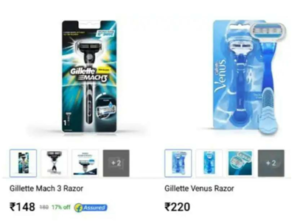
Several industrialists often question the integrity of the concept of ‘pink tax’ by justifying the varying costs on the grounds of ‘intrinsic characteristics, sales volume, difference in service’ among other reasons.[17]
But it is crucial to understand that marketing cannot be used as an excuse for adopting exploitive gendered pricing for female products. Although ‘marketing’ appears as a prima facie justification for the prices of the products, the underlying discriminatory reasons cannot be hidden for long.
When identifying the prevalence of pink tax in India is such a massive challenge in itself, beating it is even more complicated and complex. Usually there are national laws that protect its citizens from such discrimination. To give an instance, the New York State Budget for the financial year 2021 includes within its mandate, a proposal to ban ‘Pink tax’. [18] The law shall impose civil liabilities on businesses or corporations who ‘charge the “pink tax” on substantially similar products or services’. [19] In the India context, controlling and regulating ‘pink tax’ through legislation is still a distant dream. To be able to formulate a stringent legal framework to curb gendered pricing, strong ground work must be executed first. The first step involves building awareness regarding the concept for ‘pink tax’ among the masses. According to a survey, more than 67% of adults of India have never heard of ‘pink tax’ or a similar phenomenon.[20] For this, we need institutional recognition of this global phenomenon and its prevalence in India. The starting point can be a large-scale study to compare the prices of different commodities and services spread across products, brands, sizes, composition and several other variable factors. The report published by the New York City Department of Consumer Affairs named ‘From Cradle to Cane: The Cost of Being a Female Consumer’ can be a good reference point. Based on what the institutional study reveals, a nationwide campaign should be initiated to spread awareness regarding the ‘pink tax’ levied on women. For example, in New York several women joined the social media campaign called ‘#genderpricing’ by posting images of unfair pricing that they came across on a day-to-day basis.
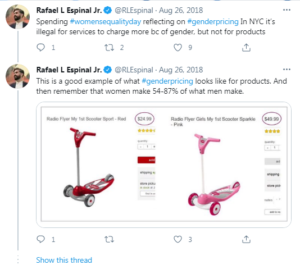
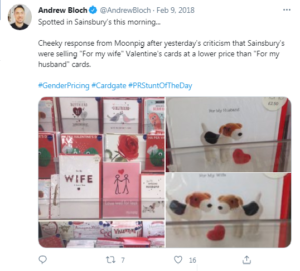
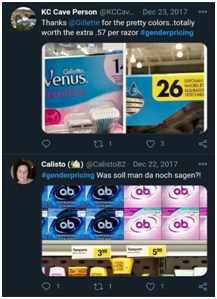
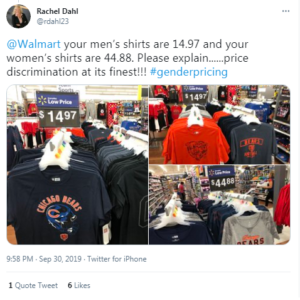
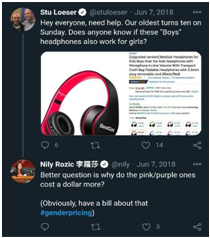
Similarly, a campaign in the name of ‘#GulabiKar’ should be initiated in India to highlight gender pricing on several media platforms so that the effect of ‘pink tax’ in India is not limited to the report. A social media campaign is a useful tool to break the existing herd mentality and question such practices. Once women are aware of the additional price, they are paying for the same utility they can get from a man’s product, their ‘money consciousness’ will encourage them to boycott discriminatory products and brands. Such resistance to purchase products that levy ‘pink tax’ will eventually lead to disintegrating the baseless justifications big corporations give for charging high prices on female products. If women voluntarily start shifting to neutral products or substitute the products they need with their male counterparts, the demand for these ‘high-priced’ products will eventually decrease while the rate of supply will remain the same. As a consequence, the organizations will be compelled to lower their prices to encourage women to start purchasing their products again. The Indian market requires a revolution to solve the problem of unequal treatment of consumers in the marketplace. For this revolution, the aggrieved segment of the society i.e., the women, must unite, mobilise and raise their voices like they did in the case of ‘Lahu ka Lagaan’.
All in all, introducing the Indian public to the concept of ‘Pink tax’ is very relevant in the current times. Although due to the subtlety of ‘pink tax’, gender pricing and its impact isn’t very apparent, but establishing its presence isn’t that complicated once a detailed analysis is undertaken, as is seen in the case of other countries. Women, throughout history, have had to fight for all things that served their interests. This one is going to be no different. But it’s reassuring to know that our battles today depend more on wifi availability, social media, and smartphones than on the consideration of male-led legislative and executive government bodies. The power women find online to collectivise and amplify their noise, is what I believe will put malpractices that feed on collective ignorance and apathy to an end.
About the author
Photo Credits: Elizabeth Pamboukian
References
-
Rick Noack, France investigates a secret ‘tax’ that targets women, The Washington Post (November 19, 2014) https://www.washingtonpost.com/news/worldviews/wp/2014/11/19/france-investigates-a-secret-tax-that-targets-women/; Meg Farris, Group Protests pink tax, says women should ask state for money back, 4WWL (November 22, 2019)https://www.wwltv.com/article/news/health/group-protests-pink-tax-says-women-should-get-money-back/289-0e958406-a68a-4543-9471-ff708291d118. ↑
-
India scraps tampon tax after campaign, BBC News (July 21, 2018) https://www.bbc.com/news/world-asia-india-44912742. ↑
-
Associated Press, Are women overcharged? France probes price of pink, Dailymail Online (November 19, 2014) https://www.dailymail.co.uk/wires/ap/article-2840654/Are-women-overcharged-France-probes-price-pink.html; Clarissa- Jan Lim, These Razors Are More Expensive For Women Than Men, Bustle (November 7, 2014) https://www.bustle.com/articles/48110-pink-tax-in-france-charges-women-higher-prices-than-men-and-it-needs-to-disappear ; Sarah Elzas, Higher prices for women, Pinkk Tax attracts attention of France’s women’s rights minister, rfi (February 2, 2015) https://www.rfi.fr/en/economy/20150130-higher-prices-women-pink-tax-attracts-attention-frances-womens-rights-minister. ↑
-
Anne-Lise Bouyer& Nicolas Kayser-Bril, Why we could not compute the “Woman Tax”, https://jplusplus.github.io/woman-tax/en.html . ↑
-
Mic, Should women’s products cost more than men;s?,YouTube (April 21, 2015) https://www.youtube.com/watch?v=RfvFVAB6nn0&feature=youtu.be. ↑
-
Ibid. ↑
-
Anna Bessendorf, From Cradle to Cane: The Cost of Being a Female Consumer, New York City Department of Consumer Affairs (2015) https://www1.nyc.gov/assets/dca/downloads/pdf/partners/Study-of-Gender-Pricing-in-NYC.pdf. ↑
-
M. Geetha, Ladies, beware the hidden pink tax, The Hindu Business Line (November 1, 2018) https://www.thehindubusinessline.com/catalyst/ladies-beware-of-the-the-hidden-pink-tax/article25393027.ece#. ↑
-
Ibid. ↑
-
Nabeela Jamil, The Horrifying Reality of the Pink Tax: Why does it Cost More to Be a Woman?,Feminism in India (October 9, 2018) https://feminisminindia.com/2018/10/09/pink-tax-women-cost/. ↑
-
Shraddha Sharma, Gender Tax: From clothing to cosmetics, why are owmen paying more for products despite earning less?,Money Control (July 28, 2020) https://www.moneycontrol.com/news/business/gender-tax-why-are-women-paying-more-for-products-despite-earning-less-4248501.html. ↑
-
Steven Horwitz, Is There Really a Pink Tax?,FEE (May 1, 2015) https://fee.org/articles/is-there-really-a-pink-tax/. ↑
-
Ibid. ↑
-
M. Geetha, Ladies, beware the hidden pink tax, The Hindu Business Line (November 1, 2018) https://www.thehindubusinessline.com/catalyst/ladies-beware-of-the-the-hidden-pink-tax/article25393027.ece# ↑
-
Usha Ram et al., Gender Socialization: Differences between Male and Female Youth in India and Associations with Mental Health, International Journal of Population Research (2014) http://downloads.hindawi.com/archive/2014/357145.pdf . ↑
-
Akshita Prasad, Indra Nooyi’s Lady Chips & The Troubling Ideas of Gendered Marketing, Feminism in India (February 12, 2018) https://feminisminindia.com/2018/02/12/lady-chips-stereotypes-gendered-marketing/. ↑
-
Associated Press, Are women overcharged? France probes price of pink, Dailymail Online (November 19, 2014) https://www.dailymail.co.uk/wires/ap/article-2840654/Are-women-overcharged-France-probes-price-pink.html ↑
-
Albany, BY, Governor Cuomo Reminds New Yorkers “Pink Tax” Ban Goes into Effect Today, New York State (September 30, 2020) https://www.governor.ny.gov/news/governor-cuomo-reminds-new-yorkers-pink-tax-ban-goes-effect-today#:~:text=The%20new%20law%20mandates%20that,goods%20or%20services%20are%20marketed. ↑
-
Ibid. ↑
-
Vidhi Damani, Pink Tax- The Additional Cost of Being a Woman, GNLU Journal of Law & Economics (August 19, 2020) http://gjle.in/2020/08/19/pink-tax-the-additional-cost-of-being-a-woman/. ↑

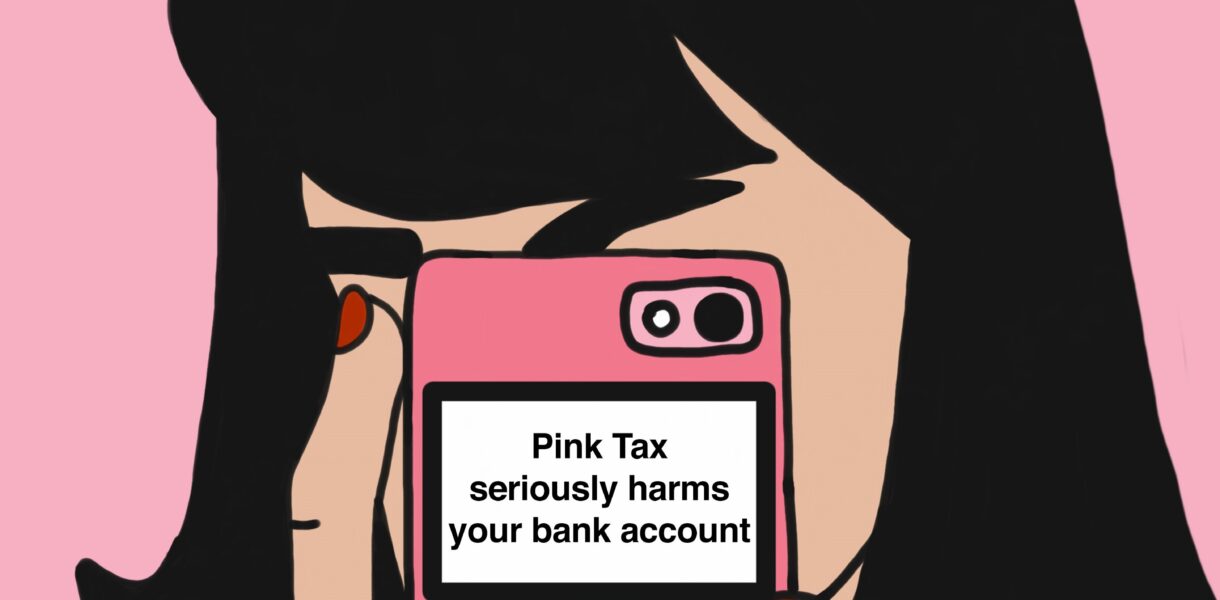


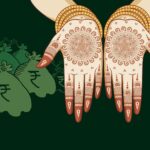
Definitely believe that which you stated. Your favorite justification appeared to be on the net the easiest thing to be aware of.
I say to you, I certainly get irked while people
think about worries that they plainly don’t know about.
You managed to hit the nail upon the top as well as defined out
the whole thing without having side-effects , people
can take a signal. Will probably be back to get more.
Thanks
Thanks for one’s marvelous posting! I truly enjoyed reading it, you are
a great author. I will make sure to bookmark your
blog and will eventually come back at some point. I
want to encourage one to continue your great job, have a nice
holiday weekend!
We’re a gaggle of volunteers and starting a new scheme in our community.
Your site provided us with helpful info to work on.
You have done a formidable process and our entire neighborhood will likely be thankful to you.
Hey there, I think your site might be having browser compatibility issues.
When I look at your blog site in Firefox, it looks fine but when opening in Internet Explorer, it has some overlapping.
I just wanted to give you a quick heads up! Other then that,
amazing blog!
Every weekend i used to visit this site, because i wish for enjoyment, as this this web site conations in fact good funny stuff
too.
Good answers in return of this matter with genuine arguments and
explaining all on the topic of that.
First off I want to say awesome blog! I
had a quick question that I’d like to ask if you do not mind.
I was curious to know how you center yourself and clear your thoughts
before writing. I have had a hard time clearing my thoughts in getting my thoughts
out. I do take pleasure in writing but it just seems like the first
10 to 15 minutes tend to be wasted simply just trying to figure out how to begin.
Any recommendations or hints? Many thanks!
A person necessarily assist to make seriously articles I’d state.
This is the very first time I frequented your web page and to this point?
I amazed with the analysis you made to make this
actual publish incredible. Wonderful process!
Thanks very nice blog!
Appreciate this post. Will try it out.
Thanks for another fantastic article. The place else may just anyone get
that kind of information in such a perfect
manner of writing? I have a presentation next week, and I am at the search for such information.
It’s really a great and helpful piece of info.
I’m glad that you just shared this helpful info with us.
Please keep us informed like this. Thank you for sharing.
Way cool! Some very valid points! I appreciate you writing
this write-up plus the rest of the website is very good.
It’s very straightforward to find out any matter on net as
compared to books, as I found this article at this web site.
Wonderful work! This is the type of information that are meant to be shared across the
net. Disgrace on Google for not positioning this post higher!
Come on over and visit my website . Thank you =)
Worldwide Provera For Sale Mastercard Accepted Shop Saturday Delivery
Hi, I do think this is a great site. I stumbledupon it 😉 I may return once
again since i have bookmarked it. Money and freedom is the
greatest way to change, may you be rich and continue to guide
others.
Good day! This is kind of off topic but I need some
help from an established blog. Is it difficult to set up your own blog?
I’m not very techincal but I can figure things out pretty
fast. I’m thinking about setting up my own but I’m
not sure where to begin. Do you have any ideas or suggestions?
With thanks
I’m extremely pleased to discover this page. I wanted to thank you for
ones time for this particularly fantastic read!!
I definitely appreciated every little bit of it and I have you book-marked
to check out new information on your site.
If you desire to improve your familiarity simply
keep visiting this website and be updated with the hottest gossip posted here.
I absolutely love your blog and find many of your post’s to be exactly I’m looking for.
Do you offer guest writers to write content to suit
your needs? I wouldn’t mind producing a post or elaborating on a few of
the subjects you write with regards to here. Again, awesome weblog!
I don’t know if it’s just me or if everyone else
encountering issues with your site. It seems like some of the written text on your posts are running off the screen. Can someone else please comment and let me know
if this is happening to them as well? This
might be a problem with my internet browser because I’ve had this happen before.
Cheers
Article writing is also a excitement, if you be familiar with afterward you can write otherwise it is complicated to write.
Its like you read my mind! You seem to know so much about this, like you wrote the book in it or something.
I think that you can do with a few pics to drive the message home a little bit, but
instead of that, this is wonderful blog. A fantastic
read. I’ll definitely be back.
If you were to bet the same quantity on each side at the appropriate sportsbook, you would
lock in a profit.
You’ve made some really good points there. I looked on the internet for additional information about the issue and found
most people will go along with your views on this website.
It’s an awesome piece of writing designed for all the web people; they will take
advantage from it I am sure.
So the written give basically memorializes what you currently knew.
This is the right site for anyone who wishes to find out about
this topic. You understand a whole lot its almost tough to argue with you (not that I really would want
to…HaHa). You certainly put a new spin on a topic that’s been discussed for years.
Wonderful stuff, just excellent!